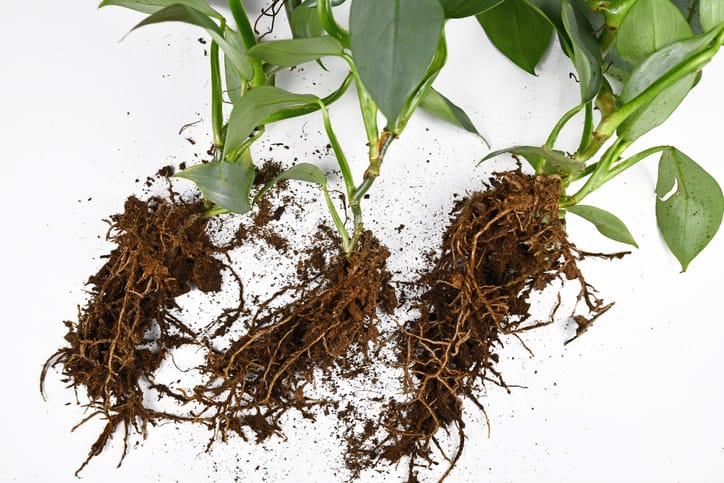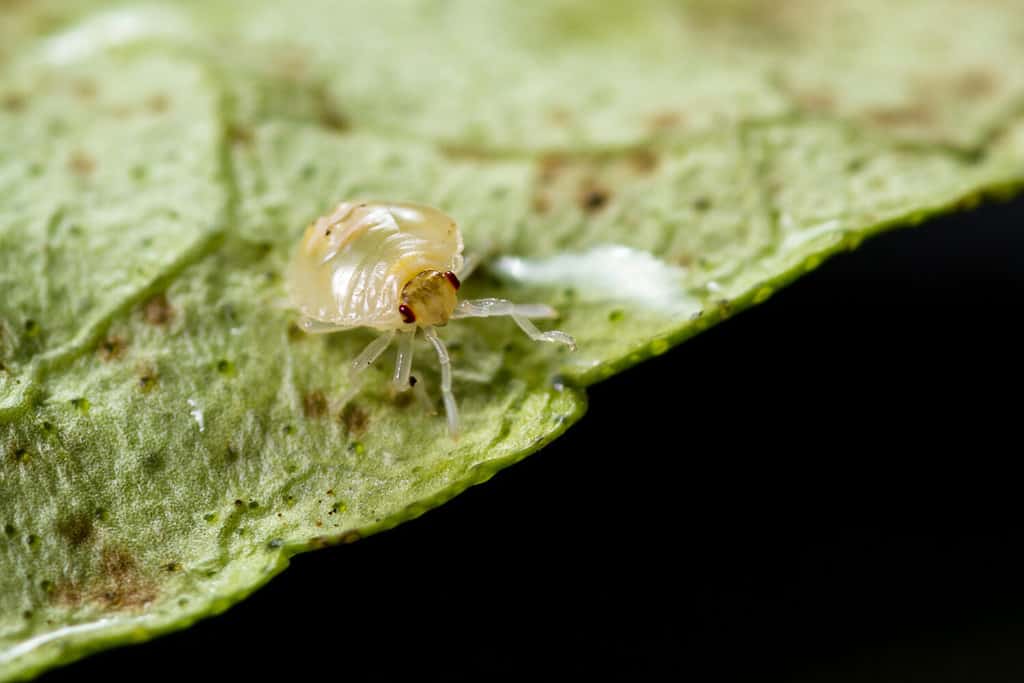Philodendrons are versatile plants with endless species and cultivars to choose from for your indoor displays. This eye-catching plant has been popular among plant parents for years thanks to its low-maintenance nature.
The silver sword Philodendron is a wonderful addition to any plant collection. In this article, we’ll cover the top silver sword Philodendron tips so you can help this beauty thrive.
Let’s dig in!
What Are Silver Sword Philodendron Plants?
Silver sword Philodendrons are a cultivar of the Philodendron hastatum species. You may see this plant labeled Philodendron hastatum ‘Silver Sword.’
The silver sword Philodendron isn’t rare, but it’s one of the less common Philodendron varieties collected by plant parents. It’s considered a moderate to fast-growing plant, depending on the conditions you provide for growth.
Appearance
Philodendron hastatum ‘Silver Sword’ is named for its silvery green leaves. The leaves are ovaline or heart-shaped, tapering to a point at the end. The vining growth and leaf shape often lead to confusion between this plant and the pothos.
Native Region
This leafy, tropical plant is native to Brazil. It prefers plenty of moisture and humidity to thrive, reminiscent of its native environment. As the Silver Sword grows under a thick canopy of trees, it doesn’t perform well in direct sunlight.
Uses
The Silver Sword is primarily used for interior design. Philodendrons were also listed in NASA’s Clean Air Study and recent studies on affordable air purification methods in combatting illness. While additional studies are needed, the Philodendron shows promising results.
Toxicity
Philodendrons, including Philodendron hastatum, are toxic to pets. Keep your plant out of reach of curious critters. Take extra caution when hanging this trailing plant, as it may become easier to access over time.
Plant Parent Experience Level
Philodendron hastatum is beginner-friendly—which is why it’s so popular! While it requires consistent moisture, it fares well with a little neglect.
If you struggle to remember when to water your plants, consider using a tracking app to remind you when it’s time.
Now, let’s get into the top silver sword Philodendron care tips.

Silver sword philodendrons are easy to repot and propagate.
©Firn/iStock via Getty Images
1. Soil Requirements
Silver sword philodendrons require well-draining soil that holds some moisture. Regular potting soil will work in a pinch, but you should mix in some perlite, coco coir, or bark to improve the airflow.
You can also find pre-mixed soil for Philodendrons and other aroid plants.
2. Choosing the Right Pot
Choose a pot with sufficient drainage for your Silver Sword philodendron. Other than that bare minimum requirement, the sky is the limit. You can put this resilient plant in a hanging container, terra cotta pot, or upcycled vessel of your choosing.
For best results, choose a pot that’s slightly larger than the Philodendron’s root system. It should be close and compact but provide room to grow.
3. Light Requirements
As mentioned previously, the Silver Sword philodendron grows in tropical areas under a thick canopy of trees. While it requires ample sunlight to photosynthesize and grow, it prefers indirect sunlight.
Set your plant away from the window sill on a nearby shelf or table. If you notice brown spots on the leaves, it could be a sign of sun scorching. Conversely, if your plant becomes leggy or growth stalls, it may require more light.
4. Watering Requirements
Aim to keep your Silver Sword’s soil moist but not dripping. Don’t let it dry completely between waterings. The frequency will vary based on the size of the plant, local climate, and season, but aiming to water once every 7-10 days in the spring and summer is a good starting point. Reduce watering in the winter.
5. How and When to Fertilize
Treating your silver sword Philodendron to organic matter or a balanced fertilizer every 4-6 weeks during the growing period will help it thrive.
Avoid fertilizing this plant during the fall and winter, as it will be entering dormancy. The unabsorbed nutrients can cause more harm than good during this period.
6. Common Pests to Watch for

Spider mites are a common problem for silver sword Philodendrons.
©Wollertz/Shutterstock.com
Silver sword Philodendron care requires constant vigilance when monitoring for pests. These plants are susceptible to the usual offenders: spider mites, thrips, mealybugs, and scale insects.
If you notice these pests, wipe them away with a warm, damp cloth and dish soap. If the issue is pervasive, consider treating it with neem oil or a gentle pesticide or fungicide.
7. Pruning Requirements
Silver sword Philodendrons don’t require pruning unless the leaves are showing signs of distress. You can remove dying leaves to redirect nutrients to the rest of the plant. Wait to remove leaves until they easily come off when pulled. This lack of resistance means the nutrients have been redirected, and the leaf is truly dead.
However, regular pruning can promote bushier growth rather than the natural vining tendencies of this plant. Prune sparingly and ensure your Philodendron is watered and healthy before cutting.
8. How and When to Propagate
Philodendrons are easy to propagate with stem cuttings. All you need is a sharp knife or scissors and some clean water.
Propagate your Philodendron in the spring or summer when it’s in active growth. Plan to water your plant a few days before propagation to ensure it’s healthy and ready to heal and grow.
- Use your clean-cutting tools to cut an established stem from your silver sword Philodendron. Ensure the stem has at least one visible node, but more nodes are better.
- Place your cutting in a clean jar or glass of water, letting the leaves rest above the water’s surface.
- Place the jar in indirect sunlight and change the water every few days.
- Once roots grow (approximately 1-2 weeks), move the cutting to well-draining potting soil.
- Water the cutting and place it back in its original position.
Once the propagated cutting is established, follow the regular care and maintenance outlined above.
9. When and How to Repot
Repot your silver sword at least every two years to give it fresh, nutrient-rich soil. Alternatively, repot when the roots start to stick through the drainage hole or the leaves become crowded.
Plan to water your Philodendron a few days before repotting to ensure it’s healthy and ready for the transition. Repotting can be stressful for plants!
10. How to Support Climbing
Give your silver sword a trellis or moss pole to climb. This plant is a natural grabber and climber and thrives when given the right tools to explore.
11. Proper Plant Placement
Place your silver sword in a temperate location away from vents and drafts. This humidity-loving plant does great in a bathroom as long as there’s natural light available.
If you notice your Philodendron stretching toward the sunlight or growing better on one side, rotate the pot to encourage even growth.
Keep the plant in a warm area that doesn’t fall below 60°F (15°C). If you use a dry heat source during the winter (such as a wood stove or heat pump) or live in an arid climate, consider placing a humidifier near this plant.
Conversely, you can group several humidity-loving plants together or place your Philodendron under a makeshift greenhouse covering.
12. Leaf Care and Cleanliness
In addition to trimming away withered foliage, you should also regularly dust or wipe down your silver sword philodendron.
Clean leaves are less likely to fall victim to pests. Additionally, removing dust and debris will help the leaves photosynthesize and promote better growth.
13. Dormancy Preparation
Philodendrons enter a dormant period every fall and winter. During this time, growth slows, nutrients are redirected, and the plant rests for the next growing season.
As the weather gets cooler, start scaling back your watering frequency. Avoid fertilizing, propagating, or repotting during this period.
The photo featured at the top of this post is © rukawajung/iStock via Getty Images
Thank you for reading! Have some feedback for us? Contact the AZ Animals editorial team.







